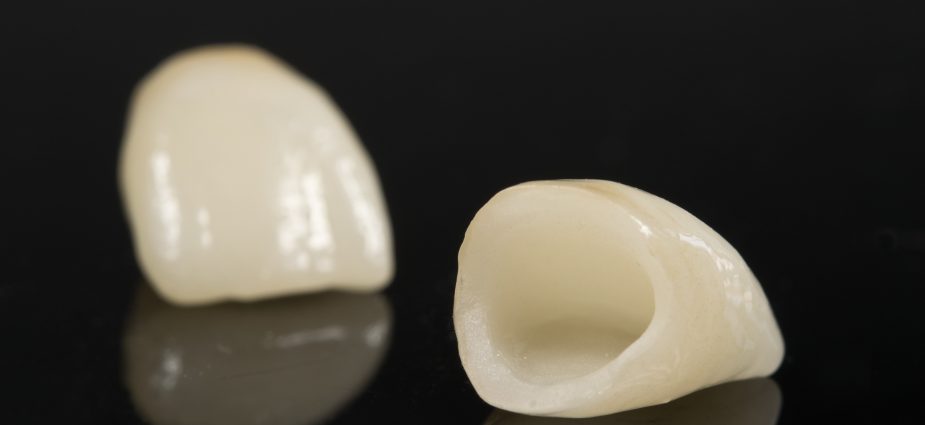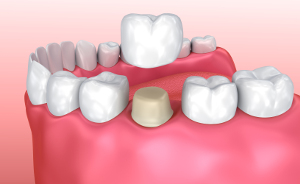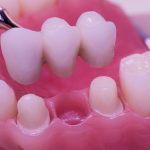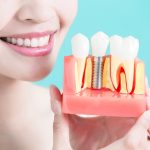Dental Crowns: Preserving Damaged Teeth
Medically Reviewed by: Dr. Robert A. Milner

On this page: Consultation & treatment planning | Procedure | Recovery | Cost | Crown materials | Find a dentist
Dental crowns, also known as “caps,” preserve the functionality of damaged teeth. This common dental restoration may be used to protect a cracked tooth, restore functionality of a tooth with excessive decay or replace a pre-existing crown. It encases a needy tooth with a custom-designed material. Dentists today have a variety of conservative treatment options through which to restore teeth. If possible, these options should be explored and discussed before selecting the full coverage crown.
Consultation and Treatment Planning
If tooth decay or damage is so extensive that veneers, direct composite bonding or other conservative treatments aren’t viable treatment options — or if you have undergone root canal therapy — your dentist will consult with you about dental crowns. Whether used to restore a damaged tooth or to create a lifelike tooth replacement for an implant, crowns can be fabricated in dental laboratories or in your dentist’s office, depending on the material.

Part of your consultation may involve taking impressions of your existing tooth (or teeth) as a basis for creating the shape and size of your restoration(s). If crowns will be used as part of a smile makeover, these impressions are used to make models for designing the new length, shape and alignment of your teeth, so that you can preview your new smile before committing to treatment.
Your dentist also will describe the tooth preparation process, as well as your options with regard to local anesthesia (to numb your teeth and surrounding areas) and sedation dentistry, if necessary. If your treatment involves placement of a temporary crown, your dentist will advise you of how long you will need to have the temporary in place and what hygiene steps to take to ensure functionality.
The Dental Crown Procedure – How it Works
To perform the crown procedure, your dentist prepares the tooth and makes a molded impression of the teeth to send to a dental laboratory. A fitted, temporary crown is created during this visit to temporarily protect the tooth while the final restoration is being made in the dental laboratory. Once completed, the crown can be cemented or adhesively bonded at a later visit.
A recent technology, CAD/CAM technology (computer-aided design/manufacturing technology) has evolved to display a 3-D picture of the teeth. A restoration is then created through milling of a ceramic block. If this technology is located in the dental office (chair-side CAD/CAM), there will be no need for a temporary or return visit for the final cementation.
Recovery and Aftercare
After your permanent crown has been placed, your dentist will provide you with information about caring for your new restoration. In general, maintain proper oral hygiene habits by brushing twice daily and flossing with dental floss or interdental cleaners (specially designed brushes and sticks) once a day. These practices will help to remove plaque from the area where the crown meets the gum and help prevent dental decay and gum disease.
Avoid chewing hard foods, ice or other hard objects, since this could damage your crown. It also is important to avoid biting your fingernails and grinding your teeth, which could significantly shorten its lifespan. If you habitually clench or grind your teeth, your dentist may recommend wearing a night-time mouth guard to offer protection while sleeping.
Prolonging the Life of Your Crown
The longevity of the full coverage crown is determined by the precision of its fit to the underlying tooth. The fit can vary tremendously and requires attention to detail by the providing dentist. An ill-fitted crown can house bacteria that may build into more serious tooth decay in years to come.
It is also important that the tooth be in a healthy state to ensure its longevity. In all cases, your dentist will evaluate the gums and supporting bone structure to ensure these supporting tissues are healthy. This protects the tooth and minimizes the potential for eventual gum recession that exposes the crown margin.
How Much Do Crowns Cost?
The cost of a dental crown depends on several factors, including the technical demands of the treatment, the training, expertise and location of the dentist, and the training and expertise of the dental technologist.
Crowns can range in price from $1,600 to $3,500 and last between 10 and 15 years or longer, though results vary depending upon your unique considerations. In aesthetically demanding situations, it can be helpful to ask the treating dentist for clinical photographs of treatment they have provided in the past to visualize the expertise and skill of the dental team being selected.
If treatment is not covered by your insurance policy, or if you don’t have insurance, you may be able to enlist the services of a third-party financing company like CareCredit or Capital One. Qualified candidates can work with a financing company to develop a monthly payment plan that best fits their budget.
Gold, Ceramic and Porcelain Crowns
The three predominant choices of restorative materials for the full coverage crowns are:
- Porcelain-fused-to-metal
- All-ceramic (all-porcelain)
- Gold
The material selected is determined by the clinical demands at hand, aesthetic demands, strength requirements, material durability and restorative space available.
Porcelain-Fused-to-Metal
Porcelain-fused-to-metal crowns provide a strong, durable and aesthetic treatment option. One of the key factors for the aesthetic and functional success of this type of crown is ensuring the preparation of the underlying tooth structure provides adequate space for the appropriate thickness of the material selected. Additionally, the artistic skill of the laboratory technologist creating the restoration will determine its esthetic appeal.
One consideration with the porcelain-fused-to-metal option is that they may tend to show the underlying metal or gold margin at the gum line as gums recede over time. Some patients opt for this type but replace it at a later date in order to maintain a higher aesthetic benefit. Porcelain-fused-to-metal crowns with an all-porcelain collar can eliminate this vulnerability.
All-Ceramic
The predominant material choices for all-ceramic crowns is zirconia or aluminous. They provide a metal-free esthetic option with a number of benefits.
By eliminating the need for the supportive metal core, an esthetic all-ceramic crown can be created with a reduced thickness of material. This makes it a more favorable treatment choice in areas with limited space. Additionally, the elimination of the metal core allows for light transmission through the porcelain for better optical, life-like properties and a higher level of aesthetics.
All-ceramic materials continue to evolve in strength and durability, but caution should still be exercised for areas of the mouth requiring heavy function. Continuing research is exploring the significant vulnerabilities of the porcelain systems in such areas.
Gold
Although not as popular a treatment choice for aesthetic reasons, gold is still indicated in some instances. For example, patients with strong bites and those with parafunctional habits (such as grinding or clenching) might be better served with a gold crown. The traditional restorative material can provide stronger support to the remaining healthy tooth structure. Gold offers a level of durability that is appropriate for teeth located in the back of the mouth (such as the molars), where they will not be highly visible. Gold crowns tend to offer greater longevity and require less preparation than porcelain and porcelain-fused-to-metal alternatives. When chewing, gold tends to be less abrasive to the opposing tooth than porcelain. This helps to prevent wearing of the teeth.
Selecting the Right Dentist
Both the dentist and the laboratory technologist play a role in the design and treatment outcome of a crown. Art and science are important factors in designing the proper anatomical features to provide the best possible fit in the mouth.
Some of the technologies and material choices for today’s crowns are fairly new, making it important to know how much experience the dentist has with the equipment used in the procedure. General dentists, family dentists, cosmetic dentists and prosthodontists may perform all treatment options; however, the level of expertise varies among dentists. For example, prosthodontists receive an additional two- to three-years of training focused on understanding complex tooth and bone structures, which may be applicable to your case.
About the Reviewer

Dr. Robert A. Milner is a cosmetic and restorative dentist serving Mission Viejo, CA since 1991 at his private practice, Dentistry For Your Smile. His expertise spans an array of popular treatments including dental implants, full mouth reconstruction, smile makeover, teeth whitening and more. He also works closely with a team of distinguished specialists to cater to a full range of services, including popular orthodontic treatments like Invisalign.
Dr. Milner received his Doctor of Dental Surgery Degree from the Marquette University School of Dentistry, where he graduated head of his class, followed by a two year associateship in Southern California. He is a member of the American Dental Association, the California Dental Association, the Academy of Oral Medicine, the American Academy of Implant Dentistry, and the American Academy of Cosmetic Dentistry.






